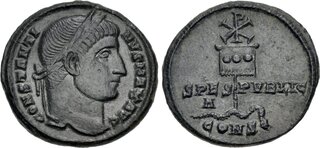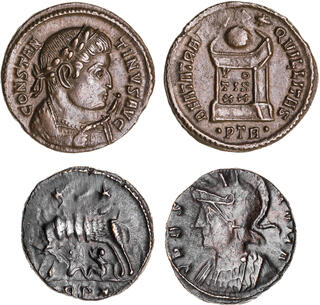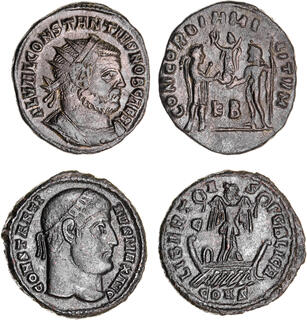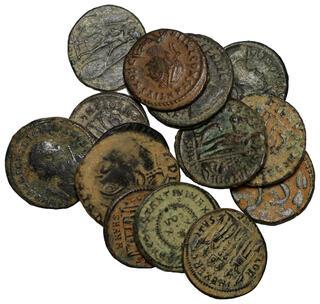Lot description:
Constantine I. AD 307/310-337. Æ Follis (19mm, 3.16 g, 12h). Constantinople mint, 1st officina. Struck AD 327. CONSTANTI NVS MAX AVG, laureate head right / SPES PVBLIC, labarum, with Christogram at top and three medallions on drapery, spearing serpent; A|–//CONS. RIC VII 19. Dark brown-green patina, scratches, smoothing. Good VF. Rare and popular type.
From the J. K. Biblical Collection. Ex Nomos 19 (17 November 2019), lot 358 (hammer CHF 5500).
There has been much speculation regarding this rare issue, minted only at Constantinople during AD 327/8, since it is the only issue of Constantine I which appears to be so overtly Christian in its symbolism. The reverse shows for the first time the labarum (a Christian emblematic replacement for the vexillum) firmly planted on the back of a wriggling serpent. Influenced by the ancient sources (the Panegyrici Latini and, in particular the Vita Constantini of Eusebius), J. Maurice, in his Numismatique Constantinienne (II, pp. 506-13), was the first to argue for such an unambiguous interpretation – the symbol of Christ piercing the dark powers of Satan – a view accepted by subsequent scholars and numismatists (P. Bruun, "The Christian signs on the coins of Constantine" in Studies in Constantinian Numismatics: Papers from 1954 to 1988 [Rome: 1991], p.61).
Constantine I was constantly adjusting his public image to meet the changing status of his political career. Such was the case with his new diademed portrait, adopted in 324 following his victory over Licinius I, which depicted Constantine I looking slightly upward, as if in the attitude of prayer. There, the emperor seemed to have been intentionally ambiguous, so that imperial images could be viewed by various groups within the empire in the context of their own hopes and aspirations (for a discussion of Constantine's use of deliberately ambiguous language and imagery, see T.G. Elliot, "The Language of Constantine's Propaganda," TAPA 120 [1990], pp. 349-353 and H.A. Drake, Constantine and the Bishops: The Politics of Intolerance [Johns Hopkins, 2000]). Is that same ambiguity, however, at work here? Beginning with the sons of Constantine and their successors (excluding Julian II, the Apostate), the labarum would appear more regularly on imperial solidi of the mid-fourth century onwards and would be interpreted by Christians and pagans alike as an emblem of imperial power. Likewise, the serpent (or dragon), which first appeared as a non-beneficent symbol on the denarii of Julius Caesar (Crawford 443/1), came to represent enemies of the state, such as "barbarians", "pagans", and "heretics" (cf. Gnecchi 2 for the serpent as a representation of Germanic tribes on a bronze medallion of Constantine I). As with the labarum, the serpent thereafter became an integral part of late Roman imperial iconography, particularly on the reverse of various solidi, where the emperor is depicted triumphally placing his foot on a serpent. In 327, however, the imagery presented on this coin may not have been so ambiguous and may have been directed specifically to those Christians living in and around the new capital.
Following his defeat of Licinius I at Chrysopolis in 324, Constantine I worked to reestablish peace and stability within a restored empire. In 325, he successfully convened and oversaw an ecumenical council of Christian bishops in at Nicaea, primarily to address the trouble produced by the Arian controversy in the eastern portion of the empire. The result of this council was the creation of the Nicene Creed and the establishment (under imperial auspices) of a theologically orthodox Christianity.
This success, however, was tempered the following year when the imperial family underwent a crisis when Constantine executed his son and heir-apparent, Crispus, and the empress Fausta, allegedly on account of mutual improper behavior. Now, a new dynastic arrangement needed to be implemented, and a period of contrition followed. Not only were the remaining three sons elevated to receive the empire jointly, but also the emperor's mother, Helena, went on a pilgrimage to the Holy Land, in part to expiate the sins of the imperial household, and during which journey she discovered a number of important holy relics, including the True Cross, which she brought back to Constantinople. Now, with religious controversies settled, the difficulties of the previous heir replaced by the three new co-heirs, and the bringing of holy relics to the new capital, Constantinople could be untainted by the faults of the old. In the context of these recent events, this coin, meant for local popular consumption, could reassure the populace that Constantine I and his rule, inspired by divine intervention and represented by the labarum, would ensure orthodox stability against all imperial enemies, represented by the serpent.
Estimate: 3000 USD |  |








